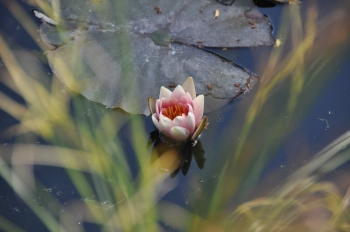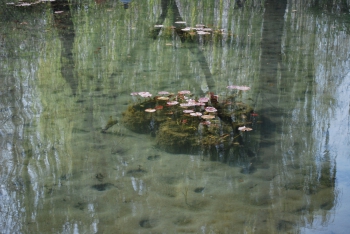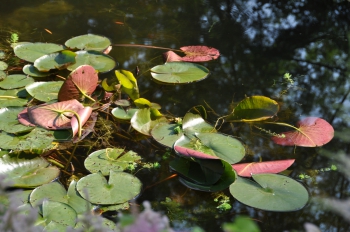August 2, 2015

When there is no wind at all, the water lilies painted by Monet at Giverny seem to be floating in the air.
The surface of the pond is such a perfect mirror that the water turns invisible.
The rafts of water lilies resemble flying carpets en route for a long trip to mysterious countries.
Posted in Water-Garden 2 Comments »
June 30, 2015

Claude Monet was never tired of painting his water lilies, because they are ever changing. They open, they close, they float on a mirror that reflects the clouds passing, the sun getting higher and lower in the sky. Monet painted his water lilies relentlessly, almost 300 times.
It is a question that visitors I guide through the gardens ask regularly: “Do you ever get tired of it?” No, never. How could one get tired of beauty?
Posted in Flower, Monet's flower garden 1 Comment »
February 19, 2015

As long as the water is still cold, the algaes don’t feel like growing. They wait patiently for better times to come.
In March, the water of Monet’s pond is so clear that the bottom looks close, offering shamelessly all its details to the view.
The uneven surface of the layer of mud resembles the moon, with mysterious craters everywhere. The planters of water lilies pop up in this desert like a lunar buggy.
The brave first leaves have made their way through the water to reach the surface, looking for sun and energy. They are still purple but will soon turn green.
In back light, when the weather is fine, innumerable stars twinckle on the surface where the light kisses the water.
This crystal clear water is the show awaiting the first Giverny visitors. In April, days get longer, warmer, and the inviting sunbeams awake grass, flowers, trees and algaes alike.
Some years, the water looses its transparency and gets almost milky, to my delight, because I like the way it absorbs the colors, I find it lovely. After a while the water clears up again.
Posted in Giverny, Monet's House, Water-Garden No Comments »
July 23, 2013
 Water lily pads floating on Claude Monet’s pond at Giverny have a strange ability of changing their color. When they first pop they are purple, like the ones upside down on the pic. The sunlight turns them green. Claude Monet, who was a good observer of his garden, had noted these two colors. On some of his Nymphea paintings he made them green with a purple circle around.
Water lily pads floating on Claude Monet’s pond at Giverny have a strange ability of changing their color. When they first pop they are purple, like the ones upside down on the pic. The sunlight turns them green. Claude Monet, who was a good observer of his garden, had noted these two colors. On some of his Nymphea paintings he made them green with a purple circle around.
Posted in Water-Garden 2 Comments »
November 29, 2010
[singlepic=167,350,350,,left]The beauty of late season at Giverny relies on the reflections on Monet’s pond.
The surrounding trees turn red, orange, yellow and dip their image into the water.
Their warm colors split in dots of changing shapes form a stunning contrast with the cold blue and perfectly defined leaves of the remaining water lilies.
This picture was taken one month ago. Now the leaves have been blown away, and Fondation Claude Monet is closed until next 1st April.
Posted in Giverny, Water-Garden No Comments »
August 1, 2010
[singlepic=156,350,350,,left]Water lilies are summer flowers.
They like a warm water and a lot of sunshine.
In Monet’s garden at Giverny, the Nympheas that grace the pond are at their peak.
Their crowns of pale petals reflect in the changing colors of the surface, creating harmonies that inspire the many painters visiting the gardens.
Posted in Flower, Water-Garden No Comments »
February 22, 2010
[singlepic=144,350,350,,left]The Palace of the Legion of Honor in San Francisco surprises French visitors by the words written on the pediment of the main entrance : Honneur et Patrie. Surprises continue with its beautiful collection of European art including five gorgeous Monets.
The biggest one faces visitors at the end of a perspective through several large rooms. It deserves this honor. This enormous canvas of Monet’s late period, painted during World War One, is certainly one of the most splendid masterpieces of the museum.
Monet focuses on two patches of water lilies floating on the pond in his garden at Giverny. Unlike many of the paintings in this series, this canvas is very bright. Vibrant reds and pinks pop out the flowers, contrasting with the soft greens of the lily pads and the pale blue of the reflected sky. Curiously enough, a cotton like cloud occupies the upper corner of the painting, when it should be reflected at the lower part of the canvas. It is one of Monet’s favorite game to mix all the landmarks to create confusion in the eyes of the viewer.
Posted in Monet Painting No Comments »
January 21, 2010
[singlepic=142,350,350,,right]Walking around Monet’s pond in summertime gives a strange feeling of deja vu.
This place especially, where the long branches of three big weeping willows reach the surface of the pond, offering views on to the blooming water lilies, looks familiar.
Claude Monet loved this spot that he painted over and over again, and that is even featured on the huge Grandes Decorations at l’Orangerie.
The vertical lines mixed with the floating water lilies and the reflections on the surface of the pond challenged his command of perspective.
Posted in Claude Monet, Giverny, Water-Garden 5 Comments »
July 16, 2008
[singlepic=50,350,350,,left]
At Monet’s time, only white water lilies grew wild in France.
They were hardy flowers, able to stand cold and frost, whereas pink or yellow water lilies were of exotic origin and needed a warm greenhouse to spend the winter.
When Monet created his water garden at Giverny and imagined a pond with floating islands of colorful nympheas, these flowers where very modern.
By the end of the nineteen century a man called Bory Latour-Marliac had the idea of cross fertilizing hardy white water lilies with exotic ones. He was successful and obtained a full palette of hardy waterlilies. In 1889, the year of the Eiffel tower, Latour-Marliac exhibited his new creations at the Universal Exhibition in Paris, where Monet saw them. Four years before he had his pond dug he conceived the idea of it by seeing the beautiful water flowers.
Would Latour-Marliac not have created his flowers, Monet would probably not have painted his Nympheas masterpieces.
Posted in Flower, Water-Garden 1 Comment »
June 29, 2008
[singlepic=60,350,350,,right]
In his water garden at Giverny, Claude Monet had a dock adornated by arches of climbing roses.
It is especially beautiful in late June when the roses are in blossom, adding their pink to the greens of the foliages.
At Monet’s time there was a boat anchored at the dock. It was used mainly by the gardener devoted to the water garden.
This gardener had a special job: every morning he had to wash the water lilies. The road nearby made them dusty, Monet who wanted to paint them, wanted them to be clean.
The gardener used to get up very early in the morning, before the master would come, and tour the pond in the boat to push the flowers under the surface with the row to clean them.
Water lily washer, isn’t it a poetic job?
Posted in Water-Garden 3 Comments »
June 10, 2008
[singlepic=51,350,350,,left]
Water lilies have their own dreams: being as light as soap bubbles and float in the air…
Monet was fascinated by the reflection of the sky and the clouds.
When the water is absolutely still the surface of his lake is a perfect mirror.
The Nympheas seem to hang in the blue sky.
Posted in Water-Garden No Comments »



